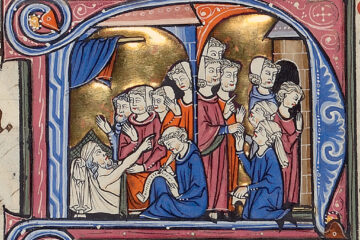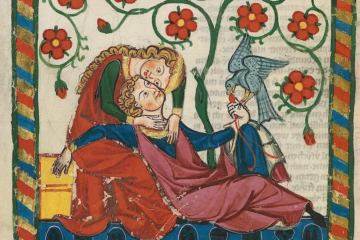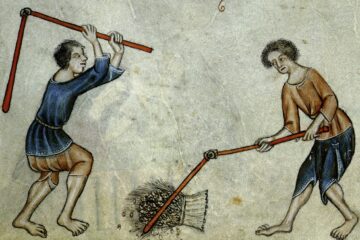Historically, the Twelve Paladins have been the protectors of the Emperor of the Sirius Empire. It is said that they were the strongest and most capable swordsmen and fighters among the Frankish nobility at the time. Often hand-picked by the Emperor, but at times mere knights rose to the title of Paladin by slaying older Paladins; since the title is for life, or until relieved by the Emperor. Paladins could not have children, own land, or get married. They owed their life, loyalty, and obedience to the Emperor and no one else. Because of this, there are tales within Rosewood of the Paladins. Mothers would often scare their children into obedience by threatening them with the vague promise that if they were to misbehave, a pair of Paladins would snatch them up. This is somewhat grounded in history since there have been a dozen or so accounts during the 12th century where Paladins were seen killing, stealing, kidnapping, burning, and destroying across Rosewood. No one dared accuse them, and since they wore identical armor, it wasn’t like a citizen could identify which one they were. The nobility feared them, the clergy despised them, the commoners respected them since they saw the Emperor’s will within them.
The tradition of having Twelve Paladins at the Imperial Court has existed in one form or another since 1079 up until the Fall of Rosewood in 1168. Twelve of them defended Emperor Charles I valiantly, slaying dozens, but eventually they were overrun. Three days later, only two were alive, the other ten perished in battle. They were discovered by German troops, and by order of the Holy Roman Emperor, they were nursed back to health and treated for their wounds. Wilhelm gave the men their freedom since he greatly respected their combat prowess. Sir Theodore “Deutsche” was the first among them to wake. In exchange for his life, and thinking the Imperial line extinguished, he offered his fealty to the Holy Roman Emperor, who agreed. Days later Sir Gawain “the Old” awoke from his sleep. His leg was beginning to rot after being slashed by an axe, and as such, it was removed. This spelled the end for Sir Gawain’s service, but despite his injury, he rode to Alparis to join his Emperor’s successor, Philip II. He continued his service well into his late years, by the time King Philip II died, he was 42 years old and still valiantly serving the King. When King Philip II’s son, Charles “the Conqueror” took the throne, he served him as well.
His is the story of the last Paladin. A relic from a bygone era. No man living has seen more Sirius blood change. Sir Gawain was Knighted at 16, as per the request of his father. This was during the penultimate year of Torrino II’s reign. After that, he witnessed the rise of Charles “the Bold”, eventually being given his Paladinship after the death of another, in 1164. He had fought many a battle for the Imperial Crown, either indirectly during Torrino “the Great’s” reign, or directly during those four years in Charles’ service. It is said he never went more than a month without fighting, and you could tell. Time hung heavy from the skin on his face. On his deathbed, he looked like he had died two decades ago, but Death was too afraid to deliver him to the Lord.
Losing his left leg during the Fall of Rosewood was the moment that changed his life forever. Where most men would yield, perhaps even sink into despair, our hero saw the light at the end of the tunnel. There comes a moment in every man’s life when he must choose what he fights for. At that moment, having sacrificed his own flesh to the Empire, Sir Gawain knew that his life, in accordance with the old Paladin Code, belonged entirely to the Emperor’s family, and by extent to God. This was his way to earn his seat in Heaven, to atone, to serve, to live and to die.
He rode, with one leg mind you, from Rosewood to Alparis, and not only that but he defended King Philip’s life on multiple occasions. Was even there when the peace treaty was signed in Bern. After that, they returned to Rosewood, where the process of Restoration began. Even then, the Last Paladin was not idle. He helped in any way he could. Since he could not walk without help, he turned to his horse, basically lived on it. If any animal were to go to Heaven, it would be old June, his steed.
Where many would retire to courtly life and managing documents, Sir Gawain took the warrior’s route and followed Philip’s son, King Charles II into war during the Unification. Not only, but he was one of the best riders in his army, directly responsible for dozens of skirmish victories and battles. When Charles II offered him an entire County for his service, he declined.
“Let the young rule. It’s the job of men like me to die for them.”
Where many would go to sleep and never wake up, where the Reaper would take them, Sir Gawain refused. He lived and lived, eventually outliving Charles II. He was there on that faithless day, the 1st of March 1206 when the King was murdered. He was next to the King when he was murdered, and was himself stabbed, not of course before taking one of the officers with him. He would have bled out, had it not been for a handmaiden who brought him to a Medicus. Sadly, his health deteriorated from then. He could no longer walk or ride. He rarely left his quarters in Fernyard, save for when he was in the infirmary during the Fourth Uprising.He would live to see the coronation of Queen Elanor in 1210. She came to visit him only months before his passing. He told her stories of her ancestors, of her people, of Rosewood. Much valuable insight and wisdom was passed onto her that day. She thanked him for his service to the Empire and to France and vowed to reorganize the Paladins to fit France’s direction. Before leaving, the Queen introduced Sir Gawain to her young son, Prince Torrino III, and then planted a kiss on the old Paladin’s forehead.
Writings of a Master of History, dated 1212, stored in the Imperial Library.
Sir Gawain, Knight of the Empire, Protector of Charles I, Philip II, Charles II, and Elanor I, the Last Imperial Paladin, Hero of Rosewood, Uncle to France, passed away on the 22nd of December 1210. If you had seen the streets of Rosewood that day, the tears shed, the wails. My, you would have thought a king had died. But no. On that day a hero died. Sir Gawain of the Sirius Empire.
In 1212, Queen Elanor I Sirius reformed the Paladin Order. Frankly, she abolished the order itself and formed a new position within the Royal Court. She restructured the Royal Guard in such a way that the position of Marshal was now alleviated of the duty of Royal Guard Captain. Instead, Elanor formed a new position, the Royal Paladin, who serves as a Captain for the Monarch’s personal and Royal Guard.
Unlike before, Paladins no longer have to serve for life and can renounce their oath at any moment. They are no longer bound to celibacy or barred from holding land. The only way one can become a Paladin is if the Monarch chooses them. Paladins no longer owe their entire being to their ruler. Instead, they can now live their own lives, while serving the Monarch as their primary obligation to the Kingdom. Since 1212 and onwards, the Paladin for the Sirius Household has been Sir Sebastian Emril.


